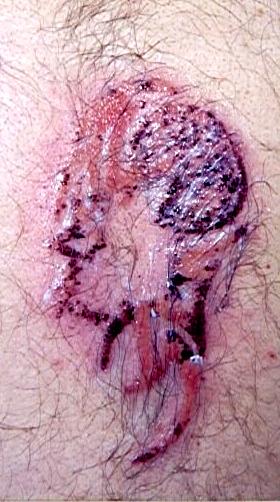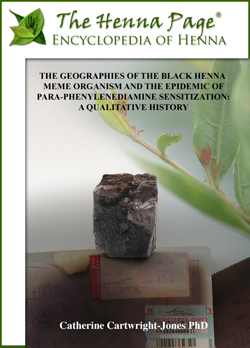 | NEW: "The Geographies of the Black Henna Meme Organism and the Epidemic of Para-phenylenediamine Sensitization: A Qualitative History" PhD dissertation on "black henna" by Catherine Cartwright-Jones PhD |
What is "Black Henna"? Why does PPD "Black Henna" do nasty things like that
picture above? What do published medical and scientific articles say about
PPD "Black
Henna" and black hair dye? What do PPD "Black Henna" injuries look like? If you are injured should you go to a doctor? How can you tell if a henna artist is using safe
henna or dangerous
PPD "Black Henna"? Why do people use black hair dye instead of henna? Is the traditional red-brown henna safe? What can happen if you get PPD "Black Henna"? It can
ruin your
life. What can happen if you dye
your hair with chemical dyes after you have PPD from a "Black henna
Tattoo"?
| ABSTRACT This qualitative history investigates the problem of the global epidemic of para-phenylenediamine sensitization through the epidemiology of the black henna meme organism. ‘Black henna’ contains para-phenylenediamine oxidative dye, a highly sensitizing chemical which produces delayed hypersensitivity reactions on the skin. ‘Black henna’ body art evolved from traditional henna body art when artists began to add para-phenylenediamine to traditional henna body art because the chemical dye produced a faster, more efficient, darker stain. This chemical addition caused blistering, scarring in the area of the pattern, with a reaction appearing five to twenty days after application in about 15% to 50% of the subjects. A maximization test of 10% para-phenylenediamine paste to skin causes sensitization in 100% of subjects in five or fewer applications. All tested 'black henna' pastes have higher concentrations of para-phenylenediamine, from 12% to 80%, and all 'black henna' temporary tattoo applications are larger than a patch test. The connection between the body art and onset of the reaction was not well understood by patrons, and often not seen by the artists. The latent severe chemical sensitivities caused by these applications often remained invisible for years. The ‘black henna’ temporary tattoo became a popular souvenir of exotic destinations and local celebratory cosmetic, as well as a profitable informal economic venture for the artist; the understanding of the risks did not proliferate along with the ‘black henna’ meme. The ‘black henna’ meme replicated from local practice into global cultural geographies through pop culture, tourism, and the Internet. Online and print media commentary about ‘black henna’ began around 1997, at which point the replication and evolution of the black henna meme organism became visible and recoverable, so the epidemiology of the ‘black henna’ meme can be recovered to trace the epidemiology of para-phenylenediamine sensitization. This work analyzes the history, geography and cultural phenomenon of black henna meme organisms in the tourist industry through memetics and discourse analysis of online commentary on ‘black henna’ and the para-phenylenediamine sensitization epidemic produced by ‘black henna’ between 1997 to 2014. This work will also estimate the date of onset and size of the sensitization epidemic, and propose a solution of management through competing meme organisms. |
| Print out a booket on the
dangers of
PPD "Black
Henna"! http://www.hennapage.com/henna/ppd/infopak.html | "Black Henna" Warnings in Italian:
" Che cos’č l’"hennč nero"?"
L’HENNE’ NON E’ NERO http://www.hennapage.com/henna/ppd/smallbroch1_italian.pdf |
| "Black Henna" Warnings in Turkish: “SİYAH KINA” NEDİR? KINA SİYAH DEĞİLDİR |
"Black Henna" Warnings in Japanese: |
|
"Black Henna Warnings in Polish: "HENNA NIE JEST CZARNA" "Czym jest "Czarna Henna"?
| "Black Henna" Warnings in French: LE HENNÉ NATUREL N’EST PAS NOIR. |
| "Black Henna" Warnings in Spanish: "LA HENNA NO ES NEGRA"
Brochure en Espanol: "LA HENNA NO ES NEGRA"
http://www.hennapage.com/henna/ppd/espsmroch2.pdf Booklet en Espanol: "Que Es La "Henna Negra?" http://www.hennapage.com/henna/ppd/espppdbook.pdf |
"Black Henna" Warnings in German |
|
Black Henna Warnings in Hebrew:
"מה היא"חינה שחורה?"
| Black Henna Warnings in Norwegian |
|
"Black Henna" Warnings in Russian! Хна НЕ БЫВАЕТ черной! Brochure: Хна НЕ БЫВАЕТ черной!
http://www.hennapage.com/henna/ppd/smallbroch1_RU.pdf Booklet: Что такое «черная хна»? http://www.hennapage.com/henna/ppd/bigbrochv_RU.pdf | "Black Henna Warnings in Dutch Booklet: "Wat is Zwarte Henna?" http://www.hennapage.com/henna/ppd/groot_nl.pdf Brochure: "Henna is NIET Zwart!" http://www.hennapage.com/henna/ppd/ppdbrochnl.pdf |
|
"Black Henna" Warnings in Estonian: Mis asi on "Must Henna?" http://www.hennapage.com/henna/ppd/bigbrochv_EST.pdf HENNA EI OLE MUST http://www.hennapage.com/henna/ppd/smallbroch1EST.pdf | "Black Henna" Warnings in Bulgarian: ХЕНАТА НЕ Е ЧЕРНА http://www.hennapage.com/henna/ppd/smallbroch1-bulgarian.pdf Какво е "Черна Хена?" http://www.hennapage.com/henna/ppd/bigbrochv-bulgarian.pdf |

